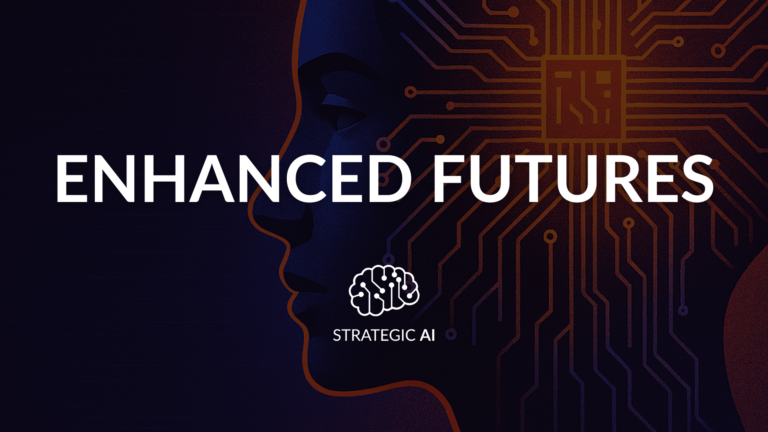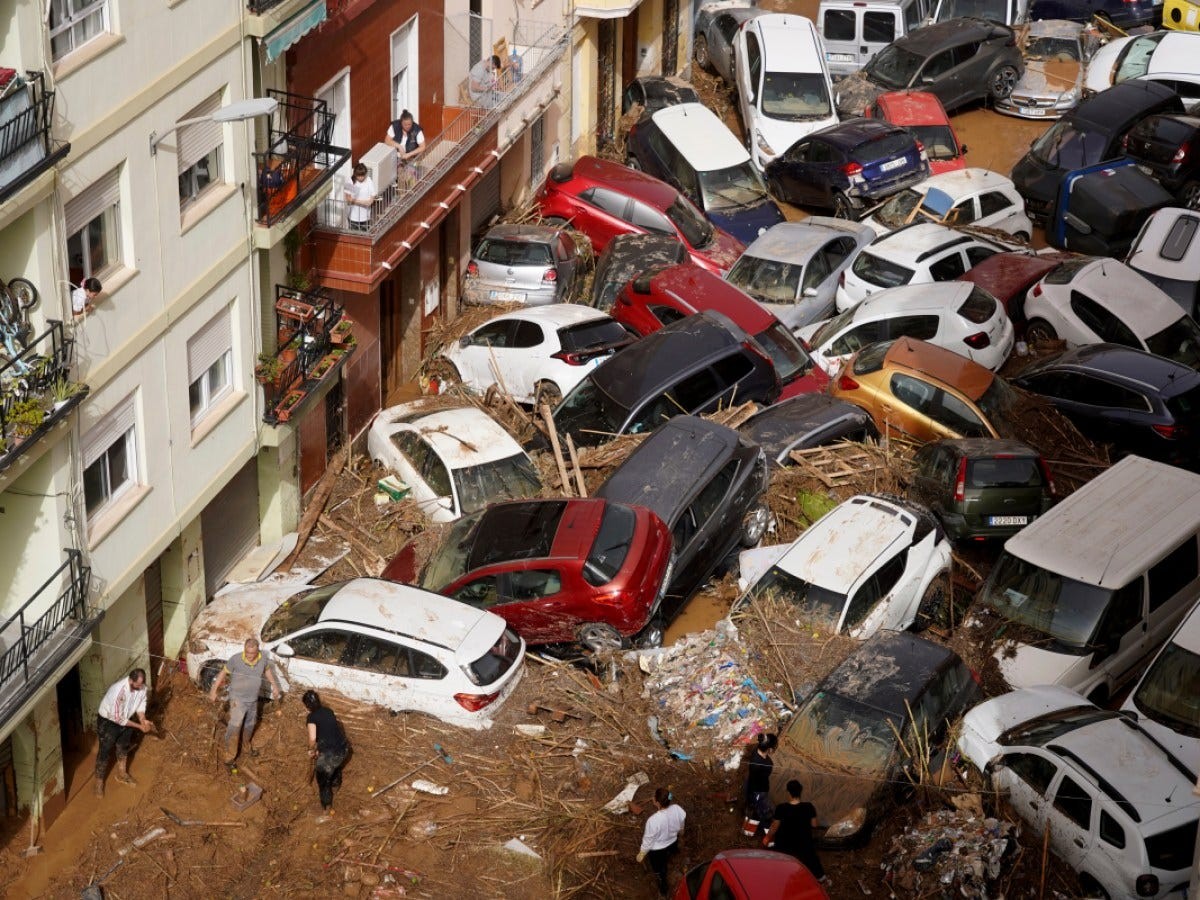
Written by Fola Yahaya

Cars piled up in the street after the ‘rain bomb’ that hit Valencia at the end of last month. Photograph: David Ramos/Getty Images
Last week’s devastating floods in Valencia, which saw a year’s worth of rain fall in a single day and sadly cost more than 200 lives, is a good example of what I call the ‘guilty until proven innocent’ problem engendered by generative AI. The image above, a pile-up of a village’s cars, quickly went viral for the wrong reasons. Not because of the stark reminder of mother nature’s raw power and unpredictability, but because the image was widely believed to be AI-generated.
We’ve now entered a new era of guilty until proven innocent. Simply put, anything digital will always be accompanied by a strong suspicion that the creator used AI to create it. I experienced this with last week’s newsletter. I added a few new subscribers, formerly of my local sports centre, who I suspect were only used to seeing me huff and puff around a squash club. They both loved the newsletter, but one had the audacity to ask if it was AI-generated and the other went so far as to question why it wasn’t!
The evolution has been startlingly swift. In just one year, we’ve moved from “this might be AI” to “this must be AI” to, perhaps most troublingly, “why isn’t this AI?” The pendulum has swung from mere suspicion to outright incredulity that someone would “waste their time” creating something manually.
This guilty until proven shift also raises another profound question: has AI already permanently altered our appreciation of human creativity? It reminds me of a moment a decade ago, wandering through a modernist art exhibition with my then six-year-old son. We stopped before a painting he dubbed “the blob,” a splodge of oil paint on canvas that my son way too loudly proclaimed he could have painted himself. But then we both took a step back, adjusted our angle of viewing, read the information card, and spent time studying the layered paint techniques and the weirdly emotional composition. And you know what? We got it. Someone far more talented than both of us had dedicated their life to the pursuit of art for art’s sake and an all-too human creation that was not Instagram-ready and so demanded a bit of work to appreciate it.
It’s incredible that just two years into the AI age, we are already devaluing human creativity.
ByteDance, the makers of TikTok, dropped a game-changing (even this phrase is getting tired) feature called X-Portrait 2 – a piece of portrait-to-animation tech which can take a single still image and morph it into a pre-existing video. What’s incredible about the demo above is the way the AI maps the emotional canvas of the fabulous actress Viola Davis in a scene from the film Fences onto a single uploaded image of an elderly lady. The lip-syncing is also pretty much spot on.
Whilst other developers like Runway (see cartoon Fola below) are getting better at this, ByteDance has a huge advantage. As the owner of TikTok, it has access to over a billion user-generated videos daily. This means that ByteDance can fine-tune its AI models using real-world expressions captured across diverse faces, lighting conditions and camera angles. So film studios, who currently spend millions on motion capture equipment and employ hundreds of animators to create realistic facial expressions, can now do this at a fraction of the cost. In the very near future, a single photographer (or more likely an AI-generated photorealistic image) combined with a reference video will be able to replace much of this infrastructure and yet again many jobs.
And yet, despite the near-term promise (and peril) of these tools, they are in no way ready for production. However, we appear to have a what I call a ‘perception-utility’ gap. The perception that, despite abundant evidence to the contrary, the utility and cost of a tool has reached a point where it should be deployed. I spotted evidence of this ‘gap’ last week in a tender for a client video campaign. The requirements included an explicit request that bidders consider using generative AI for video production!
Now this is problematic for a bunch of reasons. Firstly, it implies that the client wants to cut costs (understandable given the appointment by Donald Trump of an ambassador to the UN who wants to “defund” it). Secondly, how do hell do you quote for this!? As fun as these tools are, they are not production-ready and it’s still more cost effective to stick with a purely human workflow. The utility-perception gap will eventually narrow, but in the short term, watch out as clients increasingly devalue any service that can superficially be delivered by AI.
Whatever Sam Altman says it’s worth listening to. This week, he was out selling his vision of where AI is heading and how his company will get there first. In this new video, he makes a bold but consistent prediction about the race to achieve artificial general intelligence (AGI), or “super-duper intelligence”, as I like to call it. Super-duper AI is, according to Altman, when we have AI systems that can autonomously run an entire company.
In his recently published manifesto, he argues that we are on the verge of “The Intelligence Age”, a new era that will usher in “astounding triumphs”, including “fixing the climate, establishing a space colony, and the discovery of all of physics”. I’ve written many times on this deus ex machina approach to tech (i.e. a higher power, in this case AI, that appears as if from nowhere to save us from ourselves).
If we do reach Altman’s goal in 2025, or even 2026, all bets are off. It’s worth revisiting his manifesto to also understand how the most powerful and best-funded man in AI thinks about what’s important. For example, he has a real issue with jobs that he feels are inefficient:
“Many of the jobs we do today would have looked like trifling wastes of time to people a few hundred years ago.”
Mate. They may look like a waste of time to you, sitting in your tech ivory tower, but these are J.O.B.S. that gainfully employ people. My other beef with Sam Altman is that while he knows that “there will also be downsides”, he’s content to let others deal with the destruction that AI will wreak. He would be wise to remember Voltaire’s sage advice that with great power comes great responsibility and the old adage “if you break it, you fix it”.
The global beef with AI is that it’s coming for the jobs of creatives when it should be focusing on removing the drudgery of household chores. Well, we may well all be in luck (though again every advance comes with the sting in the tail of potential mass job loss) as the last few months have seen a step change in the way robots are trained and ultimately an acceleration towards getting them to the do the stuff that we shouldn’t really be doing.
Successive breakthroughs have introduced the new paradigm of robots being trained by doing. Rather than being fed billions of lines of code, they are learning by watching people or videos of people doing stuff. Researchers at Johns Hopkins University managed to train a robot to perform complex medical procedures solely by having it watch videos of human surgeons at work.
This video learning approach could do for surgical robotics what LLMs did for AI, allowing robots to rapidly learn and adapt to any procedure instead of hand-coding for each individual movement.
That’s all for this week. Subscribe to stay updated on the latest AI innovations and developments.
So you don’t miss a thing, follow our Instagram and X pages for more creative content and insights into our work and what we do.

Network Hub, 300 Kensal Road, London, W10 5BE, UK
We deliver comprehensive communications strategies that deliver on your organisation’s objectives. Sign up to our newsletter to see the highlights once a quarter.